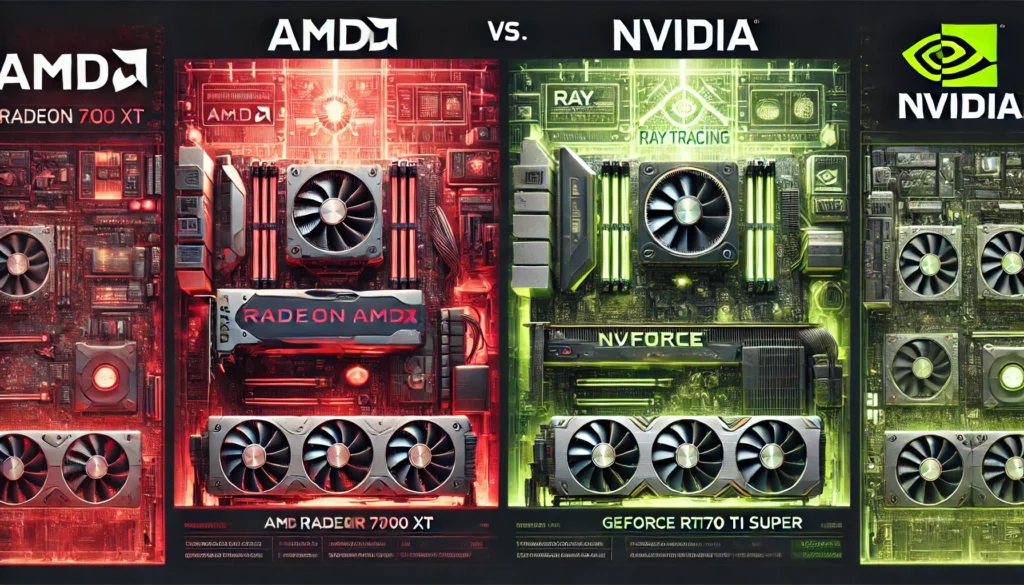(This post was generated by an LLM with direction from a human.)
When I decided to upgrade my RTX 4060, I had high hopes for the AMD Radeon RX 7900 XT. The 7900 XT came highly recommended for its exceptional performance in rasterized games, and I was excited to see what it could do for my setup. However, after a two-day trial, I found myself exchanging it for an Nvidia GeForce RTX 4070 Ti Super, a card I had previously dismissed. Here’s why.
Initial Impressions
The 7900 XT did not disappoint when it came to traditional rasterized gaming. Titles like “Cyberpunk 2077” and “Red Dead Redemption 2” ran smoothly, delivering impressive frame rates and stunning visuals. The card’s raw power in these scenarios was undeniable, and for a moment, it seemed like a perfect upgrade.
The Ray Tracing Letdown
Unfortunately, my excitement quickly waned when I tested the 7900 XT with ray traced titles. Games that heavily rely on ray tracing, such as “Control” and “Metro Exodus,” highlighted the card’s shortcomings. The performance dropped significantly, making these games less enjoyable. While AMD has made strides in ray tracing, the 7900 XT still lags behind Nvidia’s offerings in this department.
Image Generation Tools
One of my interests lies in using open source image generation tools like Automatic1111 and Fooocus. I expected the 7900 XT to perform admirably, but it was slower than anticipated. This was a critical factor for me, as I often use these tools for various projects. The slower performance was a significant downside and made me question the overall value of the card.
The Fatal Error
The final nail in the coffin came this morning when my Ubuntu install began throwing amdgpu driver timeout errors and refused to boot. Despite multiple attempts to troubleshoot and fix the issue, nothing worked. This instability was unacceptable for my setup, and it was clear that I needed to make a change.
The Unexpected Switch
I returned the 7900 XT to Micro Center and, somewhat ironically, exchanged it for the Nvidia GeForce RTX 4070 Ti Super. I had previously stated that I would ignore the 40 series Nvidia cards entirely, even making fun of the 4070 Ti Super for its seemingly ridiculous product name. But desperation led me to reconsider, and I’m glad I did.
Performance Comparison
The 4070 Ti Super performs close to, but not quite matching the 7900 XT in rasterized titles. However, when it comes to ray tracing, the 4070 Ti Super wipes the floor with the 7900 XT. The performance improvement in ray traced games is night and day, providing a much smoother and visually appealing experience.
Software Ease of Use
Another advantage of the 4070 Ti Super is the ease of setting up Nvidia CUDA software compared to AMD ROCm. The CUDA ecosystem is mature and well-supported, making it straightforward to get everything up and running. In contrast, ROCm can be finicky and less user-friendly, adding to the frustration I experienced with the 7900 XT.
Image Generation Performance
In terms of image generation performance, the 4070 Ti Super excels. It even outperforms the RTX 3090 in some cases, making it a fantastic choice for my needs. The speed and efficiency of this card with image generation tools have been impressive, far exceeding my expectations.
Conclusion
In the end, while I really wanted to love the 7900 XT, it fell short in critical areas that mattered to me. The driver issues, subpar ray tracing performance, and slower image generation speeds were dealbreakers. The 4070 Ti Super, despite my initial skepticism, has proven to be a reliable and powerful upgrade. It’s a reminder that sometimes, the best choice is the one you least expect.


